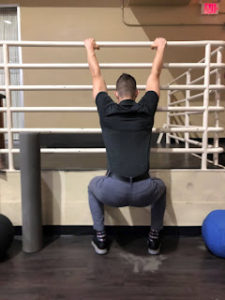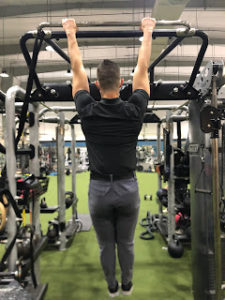
Why can’t many of us fully press our hands over our heads? Is it due to limited shoulder mobility, or just a fear of sweaty arm pits?
We are in the midst of a DC summer, so we won’t throw this theory out just yet.
However, maybe it is something far easier to explain: use it or lose it?
As we spend most of our time sitting down and slumped over our computers/phones/books, we tend to lose our ability to easily put our hands over our heads.
How well do your shoulders move? Go ahead and try this test:
After years of working with patients who deal with this problem, we’ve learned that people typically fall into one (or more) of three camps:
- Stiffness prevents overhead movement
- Weakness prevents overhead movement
- Pain prevents overhead movement
But, there’s good news! We can treat all three, simultaneously!
In fact, research suggests that the overhead training in the presence of shoulder pain can be quite beneficial.
In plain English, your shoulder pain should not keep you from working on overhead movements – they can actually be effective and therapeutic.
This is because muscles like the Serratus Anterior and Lower Trapezius are activated as we raise our arms.
These muscles help us control our scapula (fancy term for shoulder blades), which in turn stabilizes and protects the shoulder joint.
“What happens if I can’t even get my arm overhead at all?”
Train in the motion you possess! Numerous studies have shown the value of “partial range of motion” training, including a “training overflow” of 30 degrees beyond the training range.
Just keep your eyes on the prize and keep stretching ever closer to a full range of motion!
At the risk of sounding like a broken record: always remember that mobility cannot be restored overnight.
It will take MANY repetitions of purposeful movement to see noticeable progress.
Movements to Restore Shoulder Motion
Everything starts with mobility. You cannot be strong in a position if your too stiff to get there. The following movement utilize weight/assistance to improve overhead mobility.
Pull Up Holds:
Haven’t hung from the monkey bars in a few decades? Start with your feet on the ground and let your body sink gently into the stretch.
Once you’re ready, pick those feet up and hang for dear life! The longer you hold, the more time you spend working on your mobility (and strength, to boot!).
Start with small sets (1-3 second holds) and progress in duration (20-30 seconds) as your tolerance improves.


Supine Pull Overs:
Start with small sets (20-30 second sets) and progress in duration (5:00 continuous) as your tolerance improves.
As you progress, feel free to sub out the dowel for some weights and repeat the process. Treat it like a high rep strengthening exercise: sets of 12-20 reps once you’re using weights.
Lat Pull Down:
Doesn’t the top position look eerily similar to that of a shoulder press?
Treat it like a high rep strengthening exercise – sets of 12-20 reps.
Or, play with the tempo and perform 6-8 reps with an 8-10 second negative. Want to learn more about tempo? Check out this previously published blog.
Movements to Build Shoulder Strength
Now that we’ve improved our motion, let’s build strength and resilience in the range you possess. Start these movements on day one, working within your good quality range of motion.
Towel Pull Apart
Start with small sets (20-30 second sets) and progress in duration (5:00 continuous) as your tolerance improves.
Sidelying Shoulder Press
This is one of our favorites! Try sets of 12-20 and increase the weight as your tolerance improves.
Incline Press
Start with a light weight for sets of 12-20 reps.
Progress in weight and reduce the reps after one month.
Conclusion: Overhead Movement Prescription
- Mobility is a dish best served daily. With this in mind, use the “20/20 Rule” – Every 20 minutes, step away from your work station and check the integrity of your antiperspirant (aka put your arms over your head) for 20 seconds.
- Brush your teeth, brush your body – We brush our teeth at least twice daily to get rid of the gunk from our mouth. Why not do the same for the rest of our body, and undo the stiffness that we feel in our joints? Spend 3-5 minutes in the morning and evening exploring overhead positions.
- Check your work – use the Wall Flexion Test after your movements and see which movements provide the biggest bang for their buck. Assess, don’t guess!
This article was originally written by TJC-Skyline’s Dr. Dan Alcorn. Check out his blog here.


















